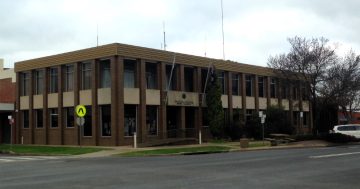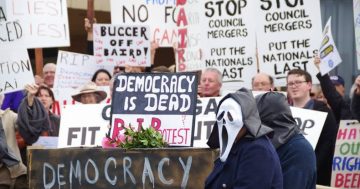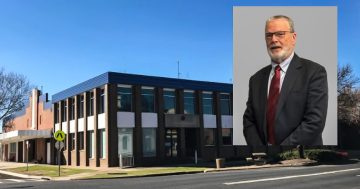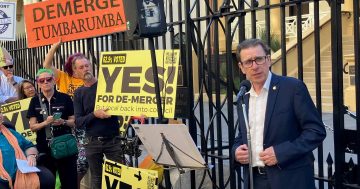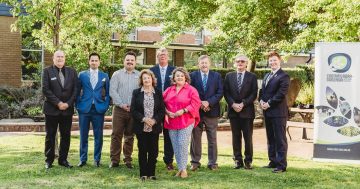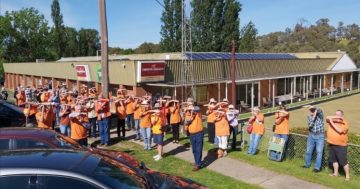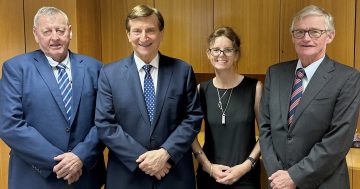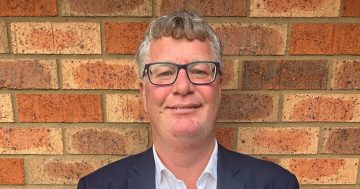
The 2016 forced merger of Cootamundra and Gundagai Shire councils has led to increased tensions between the two communities. Photo: Gundagai Council in Exile.
A 70-page report has not minced words about escalating tensions between the Cootamundra and Gundagai communities since the NSW Government forcibly merged the shires’ councils in 2016.
Reports of council employees being subjected to abuse while travelling between Cootamundra-Gundagai Regional Council offices have caught the attention of the NSW Local Government Boundaries Commission (NSWLGBC), which has recommended a demerger.
Of the four commissioners only one – the Office of Local Government’s Grant Gleeson – provided a dissenting report on the proposal.
“The Commission believes that the best outcome for the residents and ratepayers of the current LGA is for the de-amalgamation to be implemented,” the report to the minister read.
It was a stunning reversal of their 2021 recommendation, which rejected a previous demerger proposal initiated by community activist group Gundagai Council in Exile.
The report, commissioned in July 2021 by former NSW local government minister Shelley Hancock, was released this week for the consideration of the new minister Wendy Tuckerman, which will take a further 28 days.
It takes into account submissions received by the commission and presentations made at two 2022 public inquiry sessions, where it was indicated most residents and ratepayers felt a demerger would result in a better outcome financially for both areas.
Based on a Deloitte Touche Tohmatsu analysis of the financial implications of a demerger, the Commission said they accepted that would be the case for a demerged Cootamundra Council. However they said the economic outlook for a demerged Gundagai Council appeared “far more challenging”.
That said, they added that “a number of emerging revenue opportunities, together with cost-cutting measures that the community appear to accept as necessary, would help it move towards financial stability”.
They added that the ministerial requirement to fully fund any de-amalgamation costs would further assist both councils’ financial positions.

Last year “Save Tumbarumba Shire and Gundagai Council in Exile” calls for a demerger were rejected by the then NSW local government minister Shelley Hancock. Photo: Save Tumbarumba Shire.
Strong views on a lack of shared “community interests” were a consideration in the NSWLGBC recommendation, but it was the level of anger in the Gundagai community that appeared to be the tipping point.
“What has changed however is the effect that this anger is having on the mental health of the community and the council’s employees,” the report said, citing community leader and staff concerns about the animosity between the two towns.
One submission said, “By weight of population the voting pattern is heavily in favour of Cootamundra and this is causing some real angst among the Gundagai and Cootamundra communities – jealousy, envy and indeed hatred is creeping into Council and the community at all levels, which makes it impossible for governance at any level”.
Another read, “The mental health decline and stress in our community is palpable and has been recognised by the medical and clergy professions in both communities”.
Cootamundra Gundagai Regional Council’s mayor Charlie Sheahan said he was forming strategies on the way forward around the release of the Boundaries Commission report and recommendation.
“We’ve waited a long time for this report to be released,” he said. “It’s important that all community members take the time to read and understand [it].”
He said until the minister made her determination, CGRC would be running business as usual.
“We will continue to provide exemplary services and facilities to the CGRC community in its entirety,” Cr Sheahan said.
But that doesn’t mean he’s taking his eye off the ball.
“I’m going to be proactive around it and I’ll be on the front foot,” he said. “I’m not one to just sit back and leave it to the government because that leaves it purely as a political decision.”
He said that councillors and senior management would meet to provide a roadmap for the way forward.
“I can take that to the minister and say ‘here’s a plan we agree with which may assist you in achieving this’ because to be honest, she is in a really difficult position,” he said.
“I understand Minister Tuckerman has a really good comprehension of small rural councils and how they operate. When I spoke with her yesterday she genuinely had concerns about the pressure this merger had placed on the staff and our communities, particularly on their mental health and welfare.
“It’s good that the report clarified and stated that and that was something I wanted to come through this time. We can do the finances to death but [we must] start talking about the social aspect and the impact that’s having on the people and that has come through in the submissions. That has played a big part in the decision they have made.”
Original Article published by Edwina Mason on About Regional.







